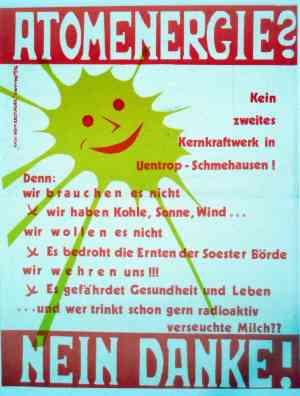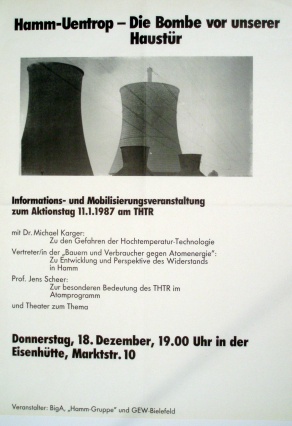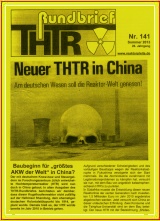| History | Videos and TV contributions |
| History of CI in Hamm | Newspaper clippings |
| Fort St. Vrain - The HTR prototype | Books on the topic |
The History of the Resistance
against the THTR in Hamm
***
The founding of the 'Citizens' Initiative for Environmental Protection Hamm'
The THTR decommissioning as a "success story" of the reconnaissance - How is a reactor decommissioned ?! - An illustrated chronicle
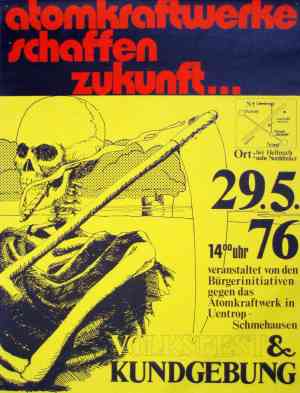 As early as 1970 there were isolated objections to the planned construction of the THTR, but there was no longer-term citizens' initiative shortly before the start of construction. Only when it became known in 1975 that a light water reactor was to be built in Hamm did the first resistance arise. Although Hamm proudly called itself a big city with its 180.000 inhabitants, the social and cultural life corresponded more to what is usually referred to as the deepest province. Most of the population showed little interest in political issues and was poorly informed.
As early as 1970 there were isolated objections to the planned construction of the THTR, but there was no longer-term citizens' initiative shortly before the start of construction. Only when it became known in 1975 that a light water reactor was to be built in Hamm did the first resistance arise. Although Hamm proudly called itself a big city with its 180.000 inhabitants, the social and cultural life corresponded more to what is usually referred to as the deepest province. Most of the population showed little interest in political issues and was poorly informed.
*
Signature campaign "For Peace ..."
In the SPD-led federal and state government of North Rhine-Westphalia there were hardly any critical voices about nuclear power plants and the majority of the CDU and FDP in Hamm approved everything that the United Electricity Works (VEW) put before them. It wasn't like that everywhere. The resistance of the Baden-Alsatian citizens' initiatives against the planned Wyhl nuclear power plant achieved a high level of publicity and also made some people in Hamm sit up and take notice. They came together and explored the possibilities for founding a citizens' initiative (BI). It was particularly interesting for us that the protest came from many rather conservative people and that the initiatives consistently acted deliberately non-violently.
*
Poster against the HTR line
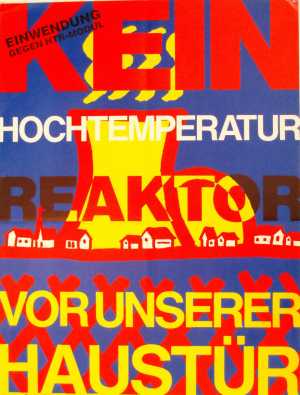 As early as 1975, the first contacts were made with the Nonviolent Action Arnsberg, which had distributed leaflets in Hamm. Until December 24, 12, objections against the planned light water reactor were collected on a smaller scale. On January 1975, 12, a pro and counter discussion with 1976 people was very well attended by the Westphalian-Lippische Landjugend (WLL) in a small village near Hamm. This event gave us a boost, and further leaflets, press articles and information booths prepared the foundation of BI. At the beginning of February, we held a weekend seminar with a spokesman for the Baden-Alsatian citizens 'initiatives in order to deepen our knowledge of the dangers of nuclear power plants and to gain first-hand basic knowledge about the organization and working methods of citizens' initiatives.
As early as 1975, the first contacts were made with the Nonviolent Action Arnsberg, which had distributed leaflets in Hamm. Until December 24, 12, objections against the planned light water reactor were collected on a smaller scale. On January 1975, 12, a pro and counter discussion with 1976 people was very well attended by the Westphalian-Lippische Landjugend (WLL) in a small village near Hamm. This event gave us a boost, and further leaflets, press articles and information booths prepared the foundation of BI. At the beginning of February, we held a weekend seminar with a spokesman for the Baden-Alsatian citizens 'initiatives in order to deepen our knowledge of the dangers of nuclear power plants and to gain first-hand basic knowledge about the organization and working methods of citizens' initiatives.
*
Event poster 1976
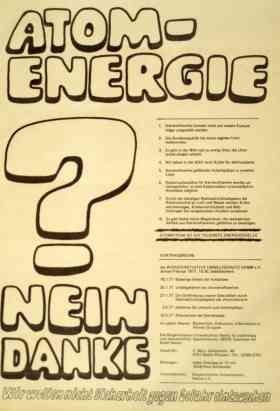 About 18 citizens took part in the official founding event of the BI on February 1976, 60, 47 of whom became members immediately. The BI joined the Federal Association of Citizens' Initiatives Environmental Protection (BBU). This umbrella organization is non-partisan, clearly prefers non-violent combat techniques and rejected nuclear power plants all over the world - including in the former Soviet Union and China. The influx of interested people to BI that started from now on could not hide the fact that we were still in a minority position in Hamm. We had repeatedly made the experience that we were most likely to mobilize indecisive citizens when pro and con debaters were present at events. After the VEW had thoroughly embarrassed itself on the podium discussion of the rural youth, they refused any further participation in public discussions and thus put themselves on the sidelines.
About 18 citizens took part in the official founding event of the BI on February 1976, 60, 47 of whom became members immediately. The BI joined the Federal Association of Citizens' Initiatives Environmental Protection (BBU). This umbrella organization is non-partisan, clearly prefers non-violent combat techniques and rejected nuclear power plants all over the world - including in the former Soviet Union and China. The influx of interested people to BI that started from now on could not hide the fact that we were still in a minority position in Hamm. We had repeatedly made the experience that we were most likely to mobilize indecisive citizens when pro and con debaters were present at events. After the VEW had thoroughly embarrassed itself on the podium discussion of the rural youth, they refused any further participation in public discussions and thus put themselves on the sidelines.
*
Poster of the camp participants in 1976 in Uentrop
In a somewhat provocative way, a short time later we made the financial contributions of the VEW for leading Hammer local politicians an issue. We raised the “Rinsche-Pfennig” for a “bribery” critical of the nuclear issue and received mail from the lawyer of the insulted monetary beneficiary.
*
1977: The rural youth invites you to a nuclear-critical play - performed on a tractor trailer in the village of Norddinker
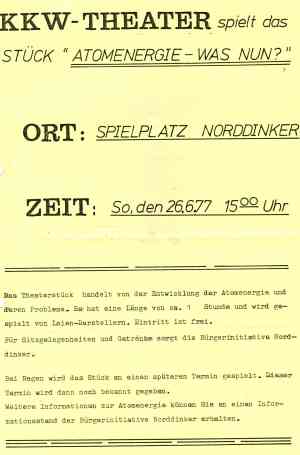 Together with the Baden-Alsatian citizens' initiatives that fought against the Whyl nuclear power plant, we received the “Schalom Prize” of the Christian Peace Services in December 1976. This award gave us a lot of courage for our difficult future work. As is so often the case with citizens' initiatives, events precipitated with us in the first year after it was founded. In 1977 we felt the politically set limits of our commitment: Of course, the VEW did not give up their plans because of a few leaflets and campaigns. Our forces were insufficient to carry out new campaigns every few weeks with the previous intensity. We had to prepare for long-term, tough resistance. The violent clashes and fights around the Brokdorf nuclear power plant not only exacerbated the climate between supporters and opponents of nuclear energy, but the internal movement debate on the question of violence unfortunately became an all-dominating dispute.
Together with the Baden-Alsatian citizens' initiatives that fought against the Whyl nuclear power plant, we received the “Schalom Prize” of the Christian Peace Services in December 1976. This award gave us a lot of courage for our difficult future work. As is so often the case with citizens' initiatives, events precipitated with us in the first year after it was founded. In 1977 we felt the politically set limits of our commitment: Of course, the VEW did not give up their plans because of a few leaflets and campaigns. Our forces were insufficient to carry out new campaigns every few weeks with the previous intensity. We had to prepare for long-term, tough resistance. The violent clashes and fights around the Brokdorf nuclear power plant not only exacerbated the climate between supporters and opponents of nuclear energy, but the internal movement debate on the question of violence unfortunately became an all-dominating dispute.*
1977: BI receives the Schalom Prize
 After the quasi-military clashes at nuclear power plant fences showed that it was almost impossible to occupy building sites, some people thought about other forms of resistance. The non-violent campaign in Dortmund and the citizens' initiative for environmental protection in Hamm started the campaign for a 10% refusal to pay electricity. Since the energy supply companies also finance the construction of nuclear power plants with the money they receive from the electricity consumers, the refusal of electricity money deprives them of the previously tacit support for a project that is strictly rejected. After distributing over 8.000 leaflets, over a hundred households in Dortmund took part in this daring act of civil disobedience. In Hamm, on the other hand, this campaign was taken note of with interest by a gradually growing public, but a major boycott did not materialize. For many people who had only just taken the first step towards rejecting nuclear power, this form of resistance initially appeared to be too extensive. Despite this failure, at least many people in Hamm received information about the various forms of civil disobedience for the first time. This gave an important impetus for thought, which was only to bear fruit later, for example through non-violent blockade actions and creative occupation actions.
After the quasi-military clashes at nuclear power plant fences showed that it was almost impossible to occupy building sites, some people thought about other forms of resistance. The non-violent campaign in Dortmund and the citizens' initiative for environmental protection in Hamm started the campaign for a 10% refusal to pay electricity. Since the energy supply companies also finance the construction of nuclear power plants with the money they receive from the electricity consumers, the refusal of electricity money deprives them of the previously tacit support for a project that is strictly rejected. After distributing over 8.000 leaflets, over a hundred households in Dortmund took part in this daring act of civil disobedience. In Hamm, on the other hand, this campaign was taken note of with interest by a gradually growing public, but a major boycott did not materialize. For many people who had only just taken the first step towards rejecting nuclear power, this form of resistance initially appeared to be too extensive. Despite this failure, at least many people in Hamm received information about the various forms of civil disobedience for the first time. This gave an important impetus for thought, which was only to bear fruit later, for example through non-violent blockade actions and creative occupation actions.
*
Poster for the Easter walk in Uentrop 1977
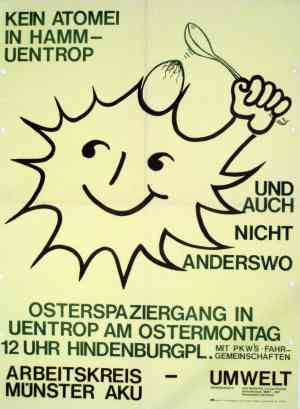 Since the VEW did not give us the opportunity to present our point of view in their "information center", an information tent of the citizens' initiative should be set up on the barbed wire-fenced area in front of the center. In a leaflet for participants in the campaign, the goals of the campaign were named and various possible forms of the conflict and our most sensible reactions were presented. After 300 people had occupied the square and set up an information tent, we handed the approaching police a special leaflet in which we justified our action and stated our peaceful intentions. Subsequently, in dialogue with the police, we negotiated a certain period of time for us to remain on the premises. Numerous conversations with police officers were held in a relaxed atmosphere.
Since the VEW did not give us the opportunity to present our point of view in their "information center", an information tent of the citizens' initiative should be set up on the barbed wire-fenced area in front of the center. In a leaflet for participants in the campaign, the goals of the campaign were named and various possible forms of the conflict and our most sensible reactions were presented. After 300 people had occupied the square and set up an information tent, we handed the approaching police a special leaflet in which we justified our action and stated our peaceful intentions. Subsequently, in dialogue with the police, we negotiated a certain period of time for us to remain on the premises. Numerous conversations with police officers were held in a relaxed atmosphere.
*
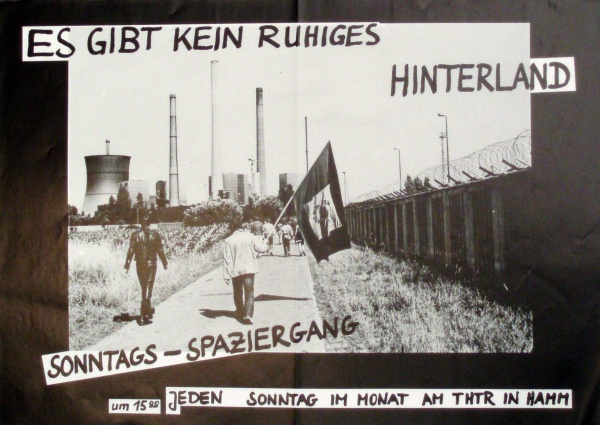
*
1977: The "Uentrop Environment Newspaper"
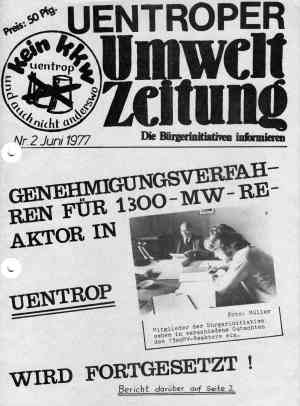 When the NRW state government put the approval process for the planned light water reactor on hold, our resistance focused entirely on the THTR, which was under construction. So far, its imminent commissioning has been viewed by the citizens' groups as an event that can hardly be prevented. Nobody could have known at the time that technical problems would delay it until 1985.
When the NRW state government put the approval process for the planned light water reactor on hold, our resistance focused entirely on the THTR, which was under construction. So far, its imminent commissioning has been viewed by the citizens' groups as an event that can hardly be prevented. Nobody could have known at the time that technical problems would delay it until 1985.
BI began to organize its resistance over the longer term. The environmental shop, which is open every day, offered a wide range of environmental literature and served us as a conference room and communication center. Everyday resistance emanated from here. With the “Uentroper Umweltzeitung” (with 4 published editions) and “Der Grüne Hammer” (with 23 published editions) we founded alternative media, as the established media groups did not allow us to speak adequately or often even defamed us. By including other environmental issues (transport policy, practical environmental protection, nature conservation, third world) in “The Green Hammer”, our contact with other groups became more intensive. So we gradually reached more and more people with our anti-nuclear arguments.
*
1977: Rural youth brochure on nuclear power plants, among other things
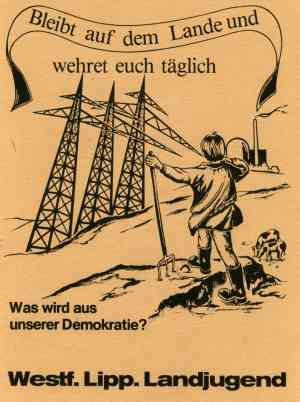 The implementation of the Easter Walk in 1977 led to one of the most difficult situations in BI history. It was originally planned by seven local citizens' initiatives from the Hammer area. Over time, more and more external groups and individuals joined the coordination meetings and pushed for more militant actions. Most of them were not traditional citizens' initiatives, but also Maoist cadre groups with followers who wanted to enforce their preferred approach with a lot of pressure and a lot of tricks. The working style and manners of the previous conferences changed suddenly. The sympathetic exchange of views that had been cultivated up to now was over. From now on, bitter power struggles overcame the question of what the Easter walk should look like. Even a conversation with representatives of the police was described by some foreign groups as a compromise with the enemy. As a result, during the Easter walk, they did not distribute leaflets against nuclear power plants, but rather tracts with allegations against local citizens' groups. A fatal situation! More than a thousand people demonstrated, but the nuclear hazard was a minor matter. And the other side never slept: In the same year, VEW built a large wall around their premises for 20 million DM.
The implementation of the Easter Walk in 1977 led to one of the most difficult situations in BI history. It was originally planned by seven local citizens' initiatives from the Hammer area. Over time, more and more external groups and individuals joined the coordination meetings and pushed for more militant actions. Most of them were not traditional citizens' initiatives, but also Maoist cadre groups with followers who wanted to enforce their preferred approach with a lot of pressure and a lot of tricks. The working style and manners of the previous conferences changed suddenly. The sympathetic exchange of views that had been cultivated up to now was over. From now on, bitter power struggles overcame the question of what the Easter walk should look like. Even a conversation with representatives of the police was described by some foreign groups as a compromise with the enemy. As a result, during the Easter walk, they did not distribute leaflets against nuclear power plants, but rather tracts with allegations against local citizens' groups. A fatal situation! More than a thousand people demonstrated, but the nuclear hazard was a minor matter. And the other side never slept: In the same year, VEW built a large wall around their premises for 20 million DM.
*
1977: Flyer about the building of the wall around the THTR, which cost 20 million DM
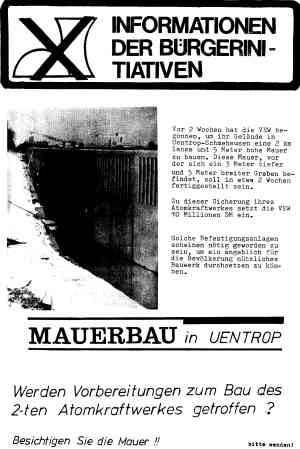 With this action it was made clear that we were prepared to break existing laws if necessary. The need arose from the behavior of our contact persons. If he ignored letters to the editor, press articles, mass objections and our leaflets, the next steps we took were rallies and demonstrations. If the VEW did not react to this either, blockades, occupations or other forms of civil disobedience were the logical consequence. Since people from different parties and worldviews work together in a citizens' initiative, it is necessary that all members find a common approach. Because our actions are not an end in themselves, the existing legal room for maneuver must first be exploited. If an important element of this leeway is left out, it would lead to serious mediation problems with its own members and the population and reduce the number of sympathetic citizens.
With this action it was made clear that we were prepared to break existing laws if necessary. The need arose from the behavior of our contact persons. If he ignored letters to the editor, press articles, mass objections and our leaflets, the next steps we took were rallies and demonstrations. If the VEW did not react to this either, blockades, occupations or other forms of civil disobedience were the logical consequence. Since people from different parties and worldviews work together in a citizens' initiative, it is necessary that all members find a common approach. Because our actions are not an end in themselves, the existing legal room for maneuver must first be exploited. If an important element of this leeway is left out, it would lead to serious mediation problems with its own members and the population and reduce the number of sympathetic citizens.
*
Poster for the Easter Walk 1977
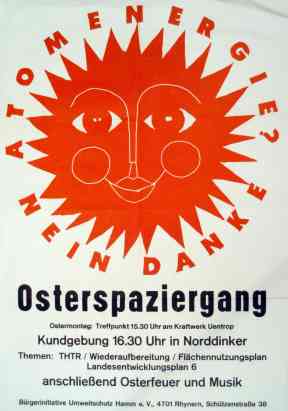 Together with other BIs, we briefly occupied the Ministry of Health and Social Affairs in Düsseldorf with a very high impact on the press, in order to obtain the free publication of the minutes of the deliberations for the planned light water reactor. In August 1976 the BI supported the six-week camp near the building site, which was mainly organized by students from Münster. From here, many small information tours by bike to the neighboring villages started, smaller plays, moritats and songs were given to the best. In September 1976 VEW wanted to open their “information center”, which cost several million DM, next to the THTR construction site. In response to this, the local citizens' initiatives have worked out a comprehensive action plan together with the Nonviolent Action Arnsberg.
Together with other BIs, we briefly occupied the Ministry of Health and Social Affairs in Düsseldorf with a very high impact on the press, in order to obtain the free publication of the minutes of the deliberations for the planned light water reactor. In August 1976 the BI supported the six-week camp near the building site, which was mainly organized by students from Münster. From here, many small information tours by bike to the neighboring villages started, smaller plays, moritats and songs were given to the best. In September 1976 VEW wanted to open their “information center”, which cost several million DM, next to the THTR construction site. In response to this, the local citizens' initiatives have worked out a comprehensive action plan together with the Nonviolent Action Arnsberg.
*
1982: 28 page brochure of the BI on the THTR
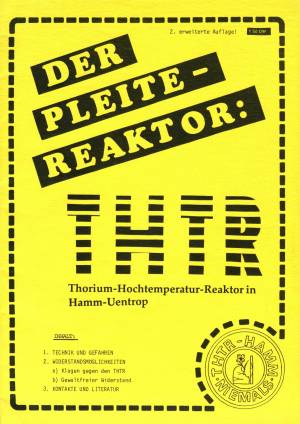 Until 1982, several days of action and demonstrations with up to 1500 people took place in Hamm. As a local citizens' initiative, we had the task of providing speakers on the THTR topic for events in other cities, as well as publishing and sending out brochures. This work took up a significant amount of our time. The planning approval procedure for the construction of the THTR was carried out in 1970/71, but the operators applied for numerous additions and changes to the permits for the partial construction over the next 15 years. We were of the opinion that if the concept were to be changed, the affected citizens would have to be involved again.
Until 1982, several days of action and demonstrations with up to 1500 people took place in Hamm. As a local citizens' initiative, we had the task of providing speakers on the THTR topic for events in other cities, as well as publishing and sending out brochures. This work took up a significant amount of our time. The planning approval procedure for the construction of the THTR was carried out in 1970/71, but the operators applied for numerous additions and changes to the permits for the partial construction over the next 15 years. We were of the opinion that if the concept were to be changed, the affected citizens would have to be involved again.
In the period that followed, three Hammer citizens complained against the THTR with the support of the citizens' initiative and also lodged a constitutional complaint. In order to stimulate the willingness to donate for the costly processes, the BI issued a “legal protection share” with an old townscape of Hamm, which could be acquired for 5 to 100 DM. In January 1981, at least 200 people drove as demonstrators to a session of the administrative court in Arnsberg.
*
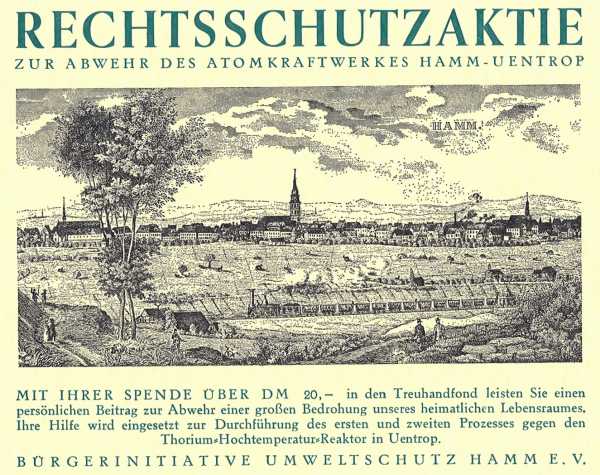
*
Rock concert against the THTR to finance the trials
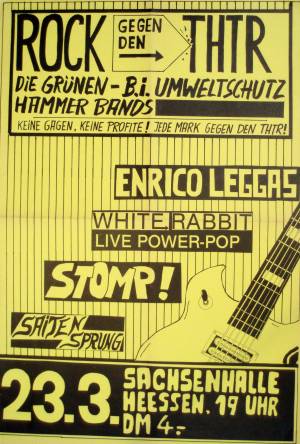 All of our diverse activities in the first half of the 80s did not deceive us about the fact that the dangers emanating from the THTR only played a subordinate role in the awareness of the nationwide environmentalists. Anyone who campaigned against the THTR could not earn laurels so quickly. After all, the reactor was about to go into operation - even we believed it had been for more than five years. Nevertheless, we did not let ourselves get down and were regularly on the mat at the Federal Association of Citizens' Initiatives Environmental Protection (BBU) or the state and federal GREENS with new campaign and action proposals. But they usually had more important things to do and provided us with very little support.
All of our diverse activities in the first half of the 80s did not deceive us about the fact that the dangers emanating from the THTR only played a subordinate role in the awareness of the nationwide environmentalists. Anyone who campaigned against the THTR could not earn laurels so quickly. After all, the reactor was about to go into operation - even we believed it had been for more than five years. Nevertheless, we did not let ourselves get down and were regularly on the mat at the Federal Association of Citizens' Initiatives Environmental Protection (BBU) or the state and federal GREENS with new campaign and action proposals. But they usually had more important things to do and provided us with very little support.
In 1983 we were concerned about the upcoming trial runs of the THTR. So we prepared carefully for a demonstration on September 17th. However, the anti-nuclear power movement was in a doldrums nationwide at this time, as the so-called peace movement and squatter scene basked in media favor. It was therefore not easy to get a large number of supporters together for the demo call.
*
1983: The city paper Distel on the THTR
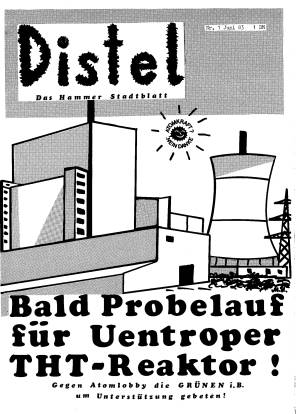 But over time it became more and more difficult, even for active BI members, to understand the complicated legal and technical processes. Doubts arose as to whether such a laborious process would make sense given the current balance of power.
But over time it became more and more difficult, even for active BI members, to understand the complicated legal and technical processes. Doubts arose as to whether such a laborious process would make sense given the current balance of power.
Nevertheless, the majority of the BI members stuck to the need to claim existing civil rights through legal channels. After all, through the years of process work, extensive knowledge of the technical problems in the construction and development of the THTR was acquired. When the nuclear industry once again boasted of its far-reaching plans for the HTR line, we were able to counter its dazzling visions with our findings. The processes were of course accompanied by years of intensive public relations work and media reporting, which repeatedly raised doubts about the bankruptcy reactor among many people.
*
Poster for the first large-scale demonstration at THTR with 3.000 people in 1983
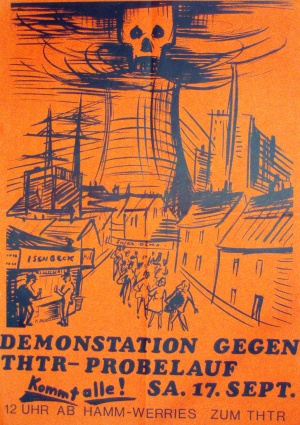 To draw attention to the demonstration, we occupied the VEW information center next to the THTR for one day 12 days beforehand. The media response was great. We also distributed a special leaflet for the miners in front of the Hammer collieries. The participation of 3.000 people at the demo was viewed by us as a minor success under the given conditions. The constructive behavior of all groups involved in the preparation and implementation of the activities was also positive.
To draw attention to the demonstration, we occupied the VEW information center next to the THTR for one day 12 days beforehand. The media response was great. We also distributed a special leaflet for the miners in front of the Hammer collieries. The participation of 3.000 people at the demo was viewed by us as a minor success under the given conditions. The constructive behavior of all groups involved in the preparation and implementation of the activities was also positive.
Up until now we had been content with publishing election test stones and questions to politicians in elections. We made the experience that our citizens' motions and resolutions were hardly heeded in local parliaments and committees, because nobody there advocated our cause. Above all, in these communities we could not look directly on the fingers of the ruling SPD, which was a very ardent supporter of the THTR.
With the participation of BI members, the municipal electoral group “Green Alternative List” (GAL) was founded in Hamm, which had cost a lot of energy and turned out to be a conflict-laden undertaking. - Some of us were now elected officials: councilor, district representative, committee member. A lively application and speech activity also started at the THTR and was documented in detail by the local press. On the one hand, it turned out to be an advantage that we could have a say in important debates on the disaster control plan for the reactor, for example.
*
BI leaflet against the threatened commissioning of the THTR
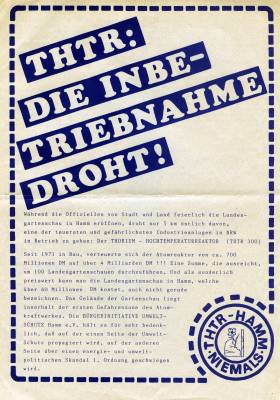 In 1985, after several cold test stages, the actual commissioning of the THTR was getting closer and closer. High time for a disaster control plan. This gave us many new opportunities to specifically point out the coming dangers and to “warm up” for the coming disputes about the final shutdown. On April 23, 1985, the Hammer city administration, the THTR operators and the NRW state government had to answer questions at a special council meeting in the large hall at Maximilianpark.
In 1985, after several cold test stages, the actual commissioning of the THTR was getting closer and closer. High time for a disaster control plan. This gave us many new opportunities to specifically point out the coming dangers and to “warm up” for the coming disputes about the final shutdown. On April 23, 1985, the Hammer city administration, the THTR operators and the NRW state government had to answer questions at a special council meeting in the large hall at Maximilianpark.
The object of the disputes was, in particular, the reduction of the safety zone from 10 to 5 kilometers, numerous inconsistencies in the implementation of aid measures for the population and the lack of security at the THTR. The population was left in the dark about the modalities of holding this special council meeting in order to be able to outsmart them all the better. In a widespread leaflet, the BI called on the population to come en masse to the special council meeting. The attached "form", which can be cut out, should also give citizens who are not so well versed in administrative issues the opportunity to put their questions about the disaster control plan in writing. After all, 48 Hammer citizens made use of it and asked a total of 395 questions.
We also drew attention to this event with over 100 display boards. A skeleton invited with the words: “Experience for yourself how you handle your safety!” In fact, around 500 people wanted to experience this.
*
BI poster for the special council meeting "Disaster Plan" from 1985
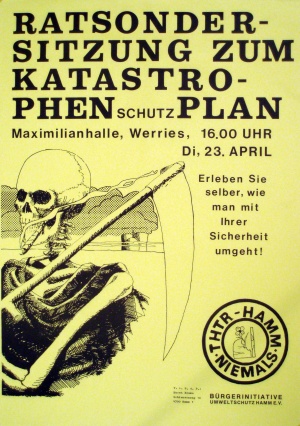 We assume that beyond 5 km there are no hazards whatsoever. So you can't get 1. iodine tablets because you don't need them. You live outside the district and theoretically nothing can happen for you. And the second question must be answered in such a way that evacuation is out of the question for you, and the third question must be answered in such a way that you do not have to worry about your animals. ”The citizens present reacted indignantly and with numerous heckling. Costumed as a skeleton, some citizens now entered the scene and I busily operated a howling hand siren. What remained were rather impotent verbal contributions from the questioners and GAL motions that were crumpled up by social democratic parliamentarians and thrown on the floor. The citizens, who were given the obligatory calls to order and reprimands by the assembly leadership, gained the experience that their safety was far worse than they had imagined in their wildest dreams. And above all, they noticed: From now on it will be really serious! Commissioning is imminent. The media reported in great detail before and after the event. The discomfort of those present and the protests became the talk of the town. With comic and satire leaflets as well as smaller campaigns, we have also addressed the explosive problem with more unconventional means. At this point in time, after 10 years of BI work, we were probably able to win over the majority of the population for our position for the first time.
We assume that beyond 5 km there are no hazards whatsoever. So you can't get 1. iodine tablets because you don't need them. You live outside the district and theoretically nothing can happen for you. And the second question must be answered in such a way that evacuation is out of the question for you, and the third question must be answered in such a way that you do not have to worry about your animals. ”The citizens present reacted indignantly and with numerous heckling. Costumed as a skeleton, some citizens now entered the scene and I busily operated a howling hand siren. What remained were rather impotent verbal contributions from the questioners and GAL motions that were crumpled up by social democratic parliamentarians and thrown on the floor. The citizens, who were given the obligatory calls to order and reprimands by the assembly leadership, gained the experience that their safety was far worse than they had imagined in their wildest dreams. And above all, they noticed: From now on it will be really serious! Commissioning is imminent. The media reported in great detail before and after the event. The discomfort of those present and the protests became the talk of the town. With comic and satire leaflets as well as smaller campaigns, we have also addressed the explosive problem with more unconventional means. At this point in time, after 10 years of BI work, we were probably able to win over the majority of the population for our position for the first time.
*
With satirical leaflets, Hammer Bürger was made aware of the dangers of THTR operations:
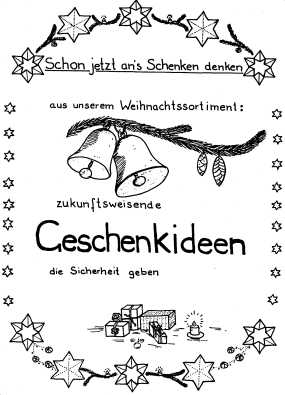 At Christmas there are iodine tablets, gas masks and radiation protection suits. Nevertheless, the THTR went into operation. Sometimes for a few hours, then again for a few days. In between downtime, shutdowns, problems, improvements, repairs, allegedly minor malfunctions, failures, interruptions, leaks and cracks. It gradually dawned on even the most gullible: We were being used as guinea pigs for their experiments by an unscrupulous nuclear mafia. When did the big "bang" come?
At Christmas there are iodine tablets, gas masks and radiation protection suits. Nevertheless, the THTR went into operation. Sometimes for a few hours, then again for a few days. In between downtime, shutdowns, problems, improvements, repairs, allegedly minor malfunctions, failures, interruptions, leaks and cracks. It gradually dawned on even the most gullible: We were being used as guinea pigs for their experiments by an unscrupulous nuclear mafia. When did the big "bang" come?
First we heard on 26 April 1986 just a few vague, vague reports of worrying incidents at a nuclear power plant in far-away Russia. In a place whose name we had never heard before and which we must remember for all future. It was not until the following days that it became frighteningly clear to us that the danger we had warned against for years was no longer theoretical, but reality ...
Suddenly everything that we urgently needed to live - air, water and food - no longer seemed life-giving, but rather life-threatening. The horror and fear increased with each passing day. Where should you get unpolluted food from and could you even still venture out of the house? Get away quickly by plane, but where to go? Study Bequerel tables in the TAZ every day.
*
The incident is measured!
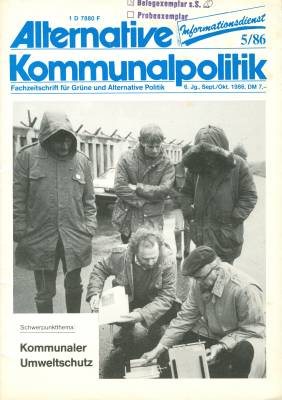 Eight days later there was a reactor accident at THTR-Hamm in which large amounts of radioactivity were released into the environment. At the 4 May 1986 a ball jammed in the ball loading system. It was blown free with radioactive gas in a kind of pneumatic tube. The United Electricity Works (VEW) claimed a short time later that the values of 50.000 Bequerels we measured with our own devices were solely due to the Chernobyl accident. It was precisely during this crucial period that the measurement and recording systems for the radioactivity emitted were interrupted. An unbelievable scandal. The stubborn denial of the nuclear industry turned out to be a bold lie because we were able to prove the opposite with our own measuring systems (which cost approx. 50.000 DM).
Eight days later there was a reactor accident at THTR-Hamm in which large amounts of radioactivity were released into the environment. At the 4 May 1986 a ball jammed in the ball loading system. It was blown free with radioactive gas in a kind of pneumatic tube. The United Electricity Works (VEW) claimed a short time later that the values of 50.000 Bequerels we measured with our own devices were solely due to the Chernobyl accident. It was precisely during this crucial period that the measurement and recording systems for the radioactivity emitted were interrupted. An unbelievable scandal. The stubborn denial of the nuclear industry turned out to be a bold lie because we were able to prove the opposite with our own measuring systems (which cost approx. 50.000 DM).
*
In the meantime, the contamination of the food has threatened the existence of the farmers. The alliance "Farmers and Consumers Against Atomic Energy" arose from the common threat in Westphalia. In a mixture of anger and desperation, they gathered at night six days after the THTR incident 10 May 1986 with a dozen tractors in a forest, sneaked up to the reactor on remote dirt roads and, completely surprisingly, blocked the two main gates for two days for the operators. 500 people demonstrated at times. From now on it went on in rapid succession:
Leaflet of the "Farmers and Consumers"
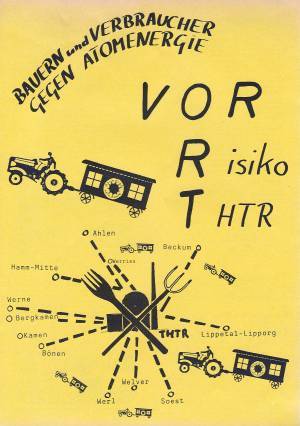 So far after the incident we have succeeded in integrating and addressing a large part of the regional population in our resistance campaigns. We encouraged them to resist and helped them overcome their own fear. Despite continuous rain and only initial media coverage, we kept growing.
So far after the incident we have succeeded in integrating and addressing a large part of the regional population in our resistance campaigns. We encouraged them to resist and helped them overcome their own fear. Despite continuous rain and only initial media coverage, we kept growing.
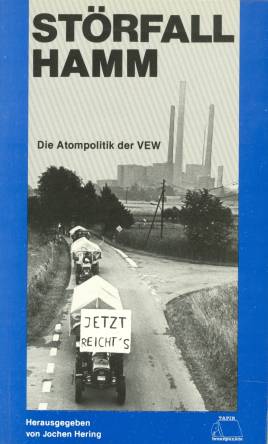 The highlight was the 7.000 rally, although the latest measurements had advised pregnant women and young children not to attend. The police did not dare to force us to drive us in front of the reactor. Many police officers present made no secret of their sympathy for our non-violent struggle.
The highlight was the 7.000 rally, although the latest measurements had advised pregnant women and young children not to attend. The police did not dare to force us to drive us in front of the reactor. Many police officers present made no secret of their sympathy for our non-violent struggle.
The plenum of blockers at THTR decided on the seventh day to suspend the blockade. Because the farmers urgently had to go back to their farms.
*
There was and is enough information - those who can read have an advantage!
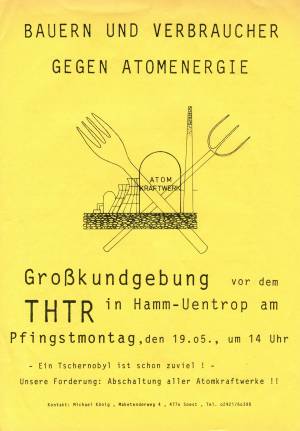
1986 - Actions at the THTR in Hamm Uentrop and in Düsseldorf!
19. May 1986: Large rally of the "farmers and consumers" with 2.500 people in front of the THTR.
28. May 1986: Council meeting in Hamm. The citizens' initiatives demand the right to speak, but this is rejected. After a short banter, the meeting was broken off. The city of Hamm continued to remain silent about the THTR incident, while other cities in North Rhine-Westphalia are selling their VEW shares and calling for nuclear energy to be phased out.
June 1, 1986: At the opening of the environmental protection week, the presence of the VEW was criticized by all the nature conservation associations involved. After a demonstration, the VEW stand was dismantled.
June 2, 1986: The "farmers and consumers" blocked the two main entrances to the THTR again. A small tent village was created. Despite the pouring rain and slow cross-regional support, the blockade was maintained for a total of seven (!) Days!
*
1986 - fear and lots of questions!
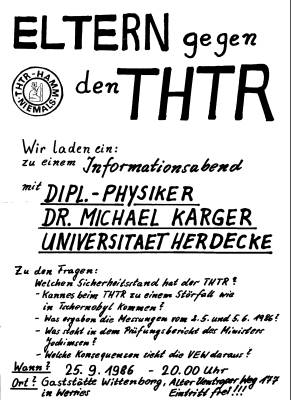 June 6, 1986: On the fifth day of the blockade, the third driveway was also blocked in order to force the handing over of a VEW measuring device after alarming reports about radioactive values. The narrow, winding dirt road was the back entrance and the last makeshift access to the reactor. But the device, which had not even been calibrated, was unsuitable for carrying out a meaningful measurement.
June 6, 1986: On the fifth day of the blockade, the third driveway was also blocked in order to force the handing over of a VEW measuring device after alarming reports about radioactive values. The narrow, winding dirt road was the back entrance and the last makeshift access to the reactor. But the device, which had not even been calibrated, was unsuitable for carrying out a meaningful measurement.
June 7, 1986: Mass rally with 7.000 people to support the blockage. The rally was decided just three days earlier and was still a huge success.
June 8, 1986: In a press release, the “farmers and consumers” write: “Our concern about the threat to livelihoods and the existence of farms was rekindled by the scandal of May 4th. It was not diminished by the appeasement and disinformation policy of the state government and the operators. On the contrary, it was reinforced by again high readings on May 21st and June 6th. "
*
Several rainbow festivals were organized along with other initiatives
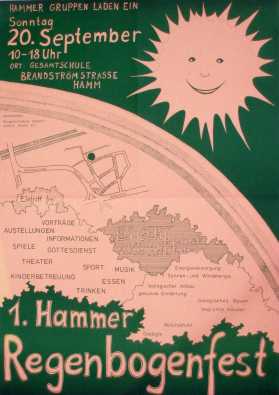 The real possibilities of GAL to influence energy policy decisions, however, were small within the framework of the local parliaments and also gave us a lot of additional work. Only a few time-privileged people could afford a constant commitment to BI and GAL. In addition, the non-partisanship that we claimed was damaged, as some BI members were constantly quoted as GAL elected officials in the press. And this despite the fact that the GAL was a communal voter community, i.e. an independent organization. Our approach to broadening resistance across party barriers turned out to be extremely difficult because members and sympathizers of other parties saw us as competitors and kept our distance.
The real possibilities of GAL to influence energy policy decisions, however, were small within the framework of the local parliaments and also gave us a lot of additional work. Only a few time-privileged people could afford a constant commitment to BI and GAL. In addition, the non-partisanship that we claimed was damaged, as some BI members were constantly quoted as GAL elected officials in the press. And this despite the fact that the GAL was a communal voter community, i.e. an independent organization. Our approach to broadening resistance across party barriers turned out to be extremely difficult because members and sympathizers of other parties saw us as competitors and kept our distance.
Maybe that's why our GAL engagement was a mistake. In 1989, at the end of the legislative period, the GAL dissolved. In any case, 95% of the public did not realize that GAL and Greens were two different organizations.
*
1987: Information event across the country
| 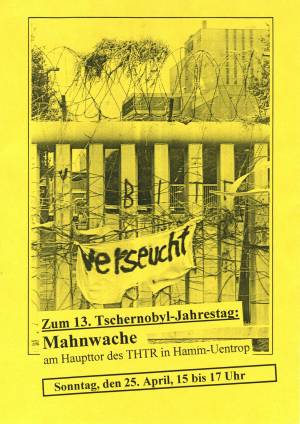 |
Since 1986 it is now also in April: "Every year ..."
Because the 26.04. is the
'Chernobyl Anniversary'
*
On August 29.08.2008th, XNUMX in Hamm / Uentrop - the big heads at the THTR
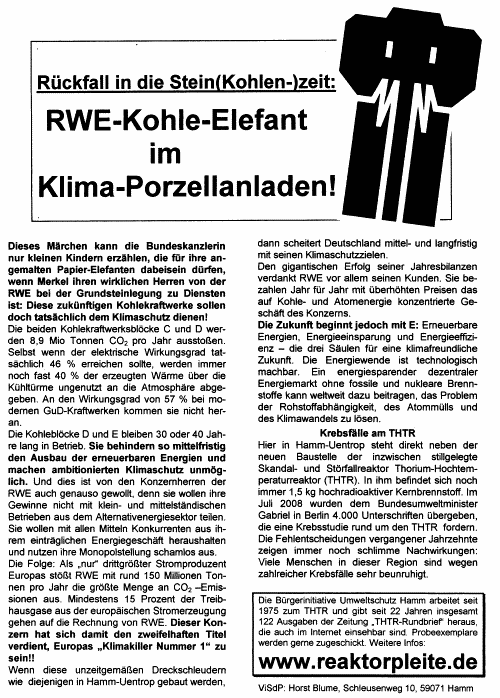
Flyer for the inauguration of a chic RWE large construction site by Chancellor Angela Merkel.
In Hamm / Uentrop, a new, great, innovative and, of course, especially green coal-fired power plant is to be built.
Yes, almost exactly where we saw the completely new, great and innovative nuclear power plant the 'THTR-300' thirty years ago ...
*
Each generation of rulers builds their own monuments.
There used to be huge pyramid tombs 'in'Then baths and theaters were built for the applauding masses, castles and fortresses were built for the courtiers, prisons, barracks and armaments factories were built for the less privileged.
After the Enlightenment, there was more investment in temples of the Muses, later, laudably, hospitals and schools came into fashion, and even later, unfortunately, garbage incineration plants and nuclear power plants.
Nowadays our mighty people find gigantic industrial and power plant ruins all over Great!
As far as everything is clear, there is only one thing that irritates me about the story; Why the hell have they been doing this in the beautiful Lippetal for 50 years?
For work on 'THTR circular', 'reaktorpleite.de' and 'Map of the nuclear world' we need up-to-date information, energetic, fresh comrades-in-arms under 100 (;-) and donations. If you can help, please send a message to: info@reaktorpleite.de
Donation appeal
- The THTR circular is published by the 'BI Environmental Protection Hamm' and is financed by donations.
- The THTR circular has meanwhile become a much-noticed information medium. However, there are ongoing costs due to the expansion of the website and the printing of additional information sheets.
- The THTR circular researches and reports in detail. In order for us to be able to do that, we depend on donations. We are happy about every donation!
Donations account: BI Umweltschutz Hamm
Usage: THTR Rundbrief
IBAN: DE31 4105 0095 0000 0394 79
BIC: WELADED1HAM
***




